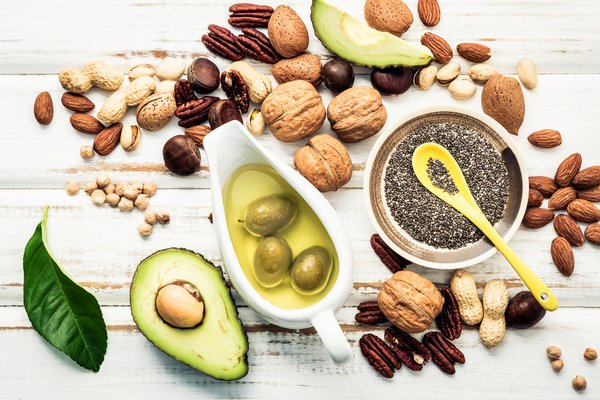
[ad_1]
As soon as the health and wellness industry started shunning low-fat approaches to health, it also began a love affair with polyunsaturated and monounsaturated fatty acids.
Still, debates continue over which is better and the effects of these nutrients on our health in the quantities we eat them, and a combination of research and popular discussion have made omega-3, -6, and -9 fatty acids among the few nutrients with “pop culture” status.
In this article, we provide you with:
- An overview of dietary fats, their structure, and their function in the human body
- Details on the differences between omega fats
- Summaries of the latest research on the health effects of omega-3, -6, and -9 fat
Types of Dietary Fat: A Review
We consume dietary fat through what we eat and drink. The fats are categorized into three overarching types based on their chemical structure and properties: saturated fats, unsaturated fats, and trans fats.
Saturated fats are solid at room temperature and usually come from animal sources, like meat, eggs, and dairy. However, nuts, coconut, palm, and avocados are several plant-based sources of saturated fat.
Unsaturated fats are generally liquid at room temperature and are referred to as oils. There are two main subcategories of unsaturated fats: monounsaturated fats and polyunsaturated fats.
Trans fats are sometimes, though rarely, found in nature and are most commonly produced in the lab. They result from a chemical process on unsaturated fat molecules to make them solid at room temperature.
What Makes Up Fats?
Fats are made up of carbon, hydrogen, and oxygen atoms. The chemical difference between the types of fats is the number of double bonds between the carbon atoms.
In a molecule of saturated fat, there are no double bonds between carbons, and carbons are instead “saturated” with hydrogen atoms. The saturation with hydrogen makes saturated fat solid at room temperature.
In monounsaturated fats, there is one double bond between two carbon atoms, and in polyunsaturated fats there are two or more double bonds between atoms. The double bonds give both monounsaturated and polyunsaturated fats a liquid state at room temperature.
Polyunsaturated fats have two or more double bonds between carbons and are also liquid at room temperature. Omega-3, omega-6, and omega-9 fats are subcategories of polyunsaturated fats with different structures. The numbers are an indication of where the double bond is found within the molecule.
The chemical structure ultimately changes the way the fats are processed and utilized in the body.
Trans fats, particularly those made by the food industry, are made by chemically breaking the double bonds between carbons and adding hydrogens in unsaturated fats to make them solid at room temperature. This process, called hydrogenation, allowed the food industry to have a plant-based solid fat that provided many of the texture qualities butter and lard provided to foods. Note that trans fats are no longer permitted in most countries because artificially made trans fats have proven negative effects on cholesterol and triglyceride levels when consumed even in moderate quantities.
There is a common misconception that plant sources of fat only contain unsaturated fats and animal sources contain only saturated fats. Fat-containing foods as they are found in nature, regardless of source, contain a combination of saturated and unsaturated fats. However, some foods have more saturated fats than unsaturated fats and vice versa. Additionally, industrial processes can remove or extract certain types of fats from products, which is how cooking oils and skim milk are made.
If you aren’t familiar with chemical structure—don’t worry. The most important things for you to know are:
- Saturated fats are solid at room temperature and are the primary type of fat in most animal food sources.
- Monounsaturated fats and polyunsaturated fats are both unsaturated fats. They are liquid at room temperature, and it is the primary type of fat in most plant sources of fat.
- Omega-3, omega-6, and omega-9 fats are categories of polyunsaturated fat.
- Animal and plant sources of fat contain both unsaturated and saturated fat.
- Trans fats are solid fats made from unsaturated fats through an industrial process called hydrogenation. These have been proven to be unsafe for human consumption, and in 2013, the FDA removed artificial trans fats from the Generally Recognized as Safe (GRAS) list for use in human food.
- Trans fat is found naturally in small quantities in meat and dairy products. It is not clear whether naturally occurring trans fats have the same negative effects on cholesterol levels as artificially made trans fats.
- Cooking oils are extracted from plant fats, and some oil manufacturers select only certain oil chemical structures to make specific health claims, improve the taste, or to make a more uniform product.
The Functions of Fats in the Body
There are no “good” or “bad” fats. Fats are just fats, and the human body needs a variety of fat types to function.
There are four primary functions of fats in the body.
- Provide energy. Together with carbohydrates, fat from the diet provides energy to our bodies. Our bodies break it down to release energy for our cells to use.
- Structural component. Every single cell in our body has a membrane that separates the inside from the outside of the cell. Membranes are made up of three types of fat molecules: phospholipids, triglycerides, and cholesterol.
- Carry vitamins. Fat from the diet carries fat-soluble vitamins A, D, E, and K inside and around the body to where they need to go.
- Other functions. While our body can convert some types of fat into other types, there are some the body cannot produce. These are called essential fatty acids, and they have specific functions in the body. Omega-3 DHA and ALA are examples of essential fatty acids that have vital functions in the body but that the body cannot produce.
What Are Omega-3, -6, and -9 Fatty Acids and Their Effects on Health?
Omega-3, -6, and -9 fatty acids are types of polyunsaturated fats. The names come from their chemical structure; the number indicates where the final double bond is in the fatty acid chain. From a health perspective, however, it is important to know that the various types of fatty acids have different functions and effects on the human body.
Omega-3
The body cannot produce omega-3 fatty acids, so they are considered essential fats. While there are many different types of omega-3s, most scientific and health research has focused on the following three:
- Alpha-linolenic acid (ALA): Present in oily plants such as flaxseed, chia, and canola
- Eicosapentaenoic acid (EPA): Present in some algae and fish and other seafood
- Docosahexaenoic acid (DHA): Present in some algae and fish and other seafood
Health Effects:
Some of the main health effects of omega-3 fatty acids include:
- Supports and improves heart health: Research has demonstrated that consuming omega-3 fatty acids through the diet can help to manage cholesterol, triglyceride, and blood pressure levels. EPA and DHA have recently been demonstrated to have a potent positive effect on cardiometabolic risk factors, and consumption of foods with ALA has a moderately beneficial effect on cardiovascular risk.
- Essential for brain development. DHA is an essential component of the brain. As babies’ brains grow in the last trimester of pregnancy, DHA intake in the pregnant person has been shown to be an important factor of brain development and cognitive function. Additionally, DHA in the first years of life, either through diet or supplementation, optimizes cognitive development and attention.
- Supports brain and mental health. A high omega-3 intake may help to lower the risk and manage symptoms of depression, Parkinson’s disease, Alzheimer’s disease, and others.
- Fights inflammation: Omega-3 fatty acids have antioxidant and anti-inflammatory properties. Omega-3 intake may help to fight inflammation associated with chronic diseases and low immune function.
Omega-6
Like omega-3s, omega-6 fatty acids are an essential fatty acid. Our bodies cannot make them, so we must obtain them from our diet. Unlike some types of omega-3s, however, omega-6s are in a variety of foods that are common in the Western diet, namely vegetable oils.
- Linoleum acid (LA): It is the primary oil type in sunflower oil, safflower oil, soybean, corn, canola oils, nuts, and seeds.
- Arachidonic acid (AA or ARA): AA is mainly found in animal-derived foods like fish, meats, eggs, and dairy. LA can be converted to AA.
Health Effects:
Omega-6 fatty acids are major sources of energy for the body. The roles of omega-6 fatty acids include:
- Acting as a substrate for the synthesis of cytokines and eicosanoids, which are important components of the inflammatory process. In other words, they are vital for immune system response.
- If there are significant quantities in the diet, they can exhibit a disordered pro-inflammatory effect.
- They can reduce LDL cholesterol and triglycerides while increasing HDL.
- Consumption of omega-6 fatty acids is associated with a lower risk of coronary heart disease.
- LA can be converted in limited amounts to EPA and then to DHA but at rates below 15%. Still, this is important for people who do not consume fish or algae sources of DHA or DHA supplements.
Omega-9
Omega-9 fatty acids are monounsaturated fats. They are not strictly essential since the human body can produce them. Additionally, omega-9 fatty acids tend to be rich in the Western diet, as they are present in a wide variety of foods.
Some of the most studied types of omega-9 fatty acids include:
- Oleic acid: Found in vegetable oils, meat, cheese, nuts, sunflower seeds, eggs, pasta, milk, olives, and avocadoes. Some vegetable oil manufacturers offer high-oleic versions of their sunflower, safflower, and canola oil.
- Erucic acid: Is present in the seeds of plants from the Brassicaceae family, including rapeseed and mustard.
Health Effects:
- Most of the health benefits of omega-9 fatty acids are attributed to oleic acid.
- Erucic acid has been shown to have toxic effects.
- Diets high in monounsaturated fatty acids like omega-9 fatty acids tend to have improved insulin sensitivity and decreased inflammation.
- Oleic acid has the potential to modulate the inflammatory and immune response, namely for infections, chronic inflammation, cardiovascular disease, and skin repair.
Are Omega-6 to Omega-3 Ratios Important?
You might have heard about the importance of maintaining a “balanced ratio” of omega-6 to omega-3 fatty acids.
The root of this concept is in evolutionary and historical research. Studies suggest that human biology evolved to have an optimal function with an omega-6 to omega-3 ratio of 1:1 to 2:1. These theories suggest that we should be consuming about the same amount of omega-6 fatty acids as omega-3 fatty acids today, as both are equally important to the diet.
Currently, Western diets have an omega-6:omega-3 ratio of between 10:1 to 25:1, indicating a significant disproportion in our actual consumption of oil types over the whole diet. This exaggerated proportion of omega-6 oils can increase the risk of chronic disease.
This a reminder that health professionals should not single out one food or nutrient as a promoter of health or disease. It is essential to consider a person’s diet as a whole and see how different foods fit into that dietary pattern and overall health to establish nutritional goals.
Main Takeaways
All types of fats are essential for our health, and different fats have different functions in our bodies. Omega3, -6, and -9 fatty acids have gained significant attention over the past decades because of their role in our health and the therapeutic potential of some specific types of fatty acids on our health and wellbeing.
If you make dietary recommendations to your clients, remember to examine the whole diet, the person’s likes and limitations, and social determinants of eating habits before making recommendations.
You can learn more about fats and oils by checking out these articles:
[ad_2]
Source link

